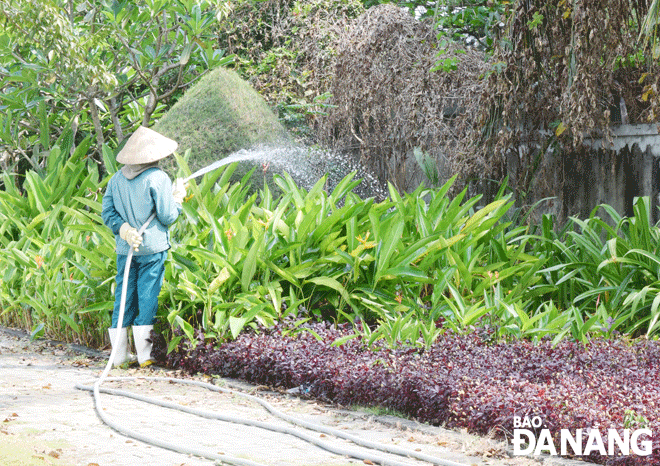World Water Day: Protecting groundwater resources
In addition to strengthening solutions to ensure domestic water supply, Da Nang has also implemented measures to protect and limit the exploitation of underground water. Especially, in response to this year's World Water Day (March 22) themed ‘Groundwater - Making the invisible visible’, the municipal Department of Natural Resources and Environment has announced a map and list of zoning areas where groundwater exploitation is restricted in the city.
 |
| According to scientists, the excessive exploitation of groundwater will lower the groundwater level, causing ground subsidence and coastal erosion. Here is a scene oftcoastal area of Ngu Hanh Son District, where groundwater is heavily exploited. Photo: HOANG HIEP |
As reported on coastal roads, especially Hoang Sa, Vo Nguyen Giap and Truong Sa, employees of many resorts in charge of taking care of public trees also use pumps sucking up groundwater to water trees. Meanwhile, scientists have long warned that over-exploitation of groundwater will cause problems, lowering the groundwater level, causing ground subsidence and coastal erosion in Da Nang.
PhD. Nguyen Thi Minh Phuong from the Duy Tan University said: “Under-exploited groundwater will weaken the structure of the aquifer, causing the surface to subside. If this subsidence occurs at the sea-shore interface, it will lead to increased wave activity and consequently coastal erosion. Therefore, it is high time for the city to take a total solution to avoid activities that deplete groundwater resources”.
According to the municipal Department of Natural Resources and Environment, in recent years, the city has paid great attention to the management of groundwater resources, so there have been projects and programmes to investigate groundwater resources.
The municipal People's Committee has directed the investigation and research to determine the underground water reserve in the area as calculated as 342,437m3/day, of which the water reserve in the hole aquifers is 125,964m3/day and 216,473m3/day in the fissure aquifers. However, the city only determined that the exploitable groundwater reserve is 73,898m3/day, accounting for 21.6% of the calculated groundwater reserve.
 |
| Currently, the city is implementing solutions to protect groundwater. An employee of a resort in Ngu Hanh Son District pumps groundwater to water plants. Photo: HOANG HIEP |
In order to limit the exploitation of underground water sources, on March 14, the municipal Department of Natural Resources and Environment announced the list and map of zoning areas where groundwater exploitation is limited in the city according to Decision No. 339. /QD-UBND dated January 25, 2022 with the limited exploitation area of 248,607km2 in 55/56 communes and wards with 3 restricted areas.
Currently, there are 218 underground water extraction works with a cappacity of 10m3/day/work or more with a total exploitation flow of more than 13,700m3/day, of which the most is in Ngu Hanh Son District with 136 works involving a total groundwater extraction volume of 6,321m3/day, followed by Son Tra and Lien Chieu districts.
The Da Nang Department of Natural Resources and Environment has asked underground water exploitation enterprises to have financial obligation reports, log books of groundwater exploitation and some accompanying requirements. In the past 3 years, enterprises have very well fulfilled the above-mentioned requirements.
Any enterprises are found exploiting in excess of the permitted reserves, exploiting improperly the contents of the permit, damaging groundwater resources, failing to fulfill its financial obligations, they will suffer administrative penalties.
This year’s theme ‘groundwater’, draws attention to the hidden water resource that has always been critically important but not fully recognized in sustainable development policymaking.
Under the title ‘Groundwater – Making the invisible visible’, this year’s campaign will explain groundwater’s vital role in water and sanitation systems, agriculture, industry, ecosystems and climate change adaptation.
The overarching message of the campaign is that exploring, protecting and sustainably using groundwater will be central to surviving and adapting to climate change and meeting the needs of a growing population.
Reporting by HOANG HIEP – Translating by A.THU